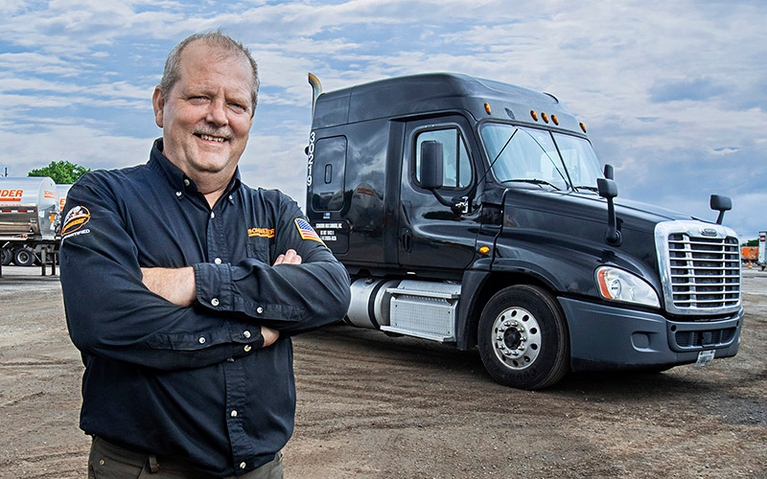How to become an owner-operator: 10 steps to take
April 24, 2025

Estimated reading time: 4 minutes
Transitioning from a company truck driver to an owner-operator is a big decision that comes with extra responsibilities. Running a successful business comes with a lot of decision making, from choosing the right truck to managing finances.
For company drivers with the experience and desire to start their own trucking company, here are 10 steps to consider about how to become an owner-operator.
10 steps to becoming an owner-operator truck driver
1. Understand what an owner-operator is.
The first place to start is to know what an owner-operator does and how they differ from company drivers. Owner-operators make decisions about things like:
- How to run their company.
What freight to haul.
Whether to contract-on with a carrier or run under their own authority.
How to handle taxes, licensing and operating expenses.
As their business grows, some owner-operators decide to lease or own multiple trucks and trailers and manage a small fleet of their own drivers.
2. Have the right experience.
It can be beneficial to have some experience in the trucking industry before you become an owner-operator.
Most motor carriers require owner-operators who contract-on with them to have experience. Schneider, for example, requires at least six months of CDL truck driving experience before someone can contract-on as a van truckload, tanker or drayage owner-operator.
Even if you’re going to operate under your own authority, it’s not a bad idea to run as a company driver to learn about the industry first.
3. Decide if this is the right step for you.
Becoming an owner-operator is a life-changing decision. To make sure starting a trucking business is the right move, ask yourself these key questions:
- Do I have the finances available to become an owner-operator?
How will becoming an owner-operator benefit me (and my family)?
What will this do to my time at home, and how will time at home affect my earnings?
How much revenue will I need to generate to be successful?
What kind of freight do I want to haul?
What regulations will I have to follow?
4. Calculate the costs associated with running a trucking business.
How much it costs to be an owner-operator varies based on many factors, including the kind of truck you operate and how you run your business.
Some of the biggest expenses you should expect as an owner-operator include:
- Truck payment(s).
Truck maintenance.
Insurance.
Fuel.
Taxes.
5. Plan how to generate revenue.
As an owner-operator, your goal is to maximize your revenue potential. While the obvious way to generate revenue is by hauling freight, there are factors that go into how much you can make.
Before making the move to business ownership, consider the following:
- Decide how hard you want to run your business.
Know what type of freight works best for how you want to operate.
Consult a tax accountant and/or attorney for financial and legal help.
Learn how to use Excel spreadsheets to manage your finances.
Think through how you are going to get loads.
6. Figure out which business structure you’ll follow.
There are three common business structures owner-operators regularly choose from (although other structures do exist, so be sure to do your homework). They are:
- Sole proprietorship.
Partnership.
Limited liability companies (LLCs).
Each option comes with its own advantages. We recommend consulting a legal and/or tax professional to help you determine which structure best suits your business.
7. Decide if you are going to lease or purchase a truck.
As an owner-operator, you’ll have a few options when it comes to the truck you operate. Some of the most common include:
- Purchasing a brand-new truck from a dealership.
Purchasing a used truck from somewhere like Schneider Trucks.
Leasing a new or used truck from a place like SFI Trucks and Financing.
8. Get insurance.
Insurance is a must for owner-operators to protect themselves and their business.
The type of insurance you need to obtain depends on how you choose to run your business:
- If you operate under your own authority, you are responsible for all insurance needs.
If you do business with a motor carrier and run under its authority, the motor carrier may provide some insurance coverage and discounts.
It’s important to consider potential insurance costs when determining how you are going to operate your business.
9. Obtain required documentation.
Before you can hit the road as an owner-operator, you’ll need to secure the right documentation. What you need depends on whether you run under your own authority or lease-on with a motor carrier, but may include:
- USDOT/Motor Carrier Authority (MC number).
Unified Carrier Registration (UCR).
Heavy Vehicle Use Tax (HVUT).
International Registration Plan (IRP).
HazMat endorsements (if you’re hauling hazardous materials).
10. Ensure regulatory compliance.
Owner-operators must stay up to date on the Department of Transportation (DOT) and Federal Motor Carrier Safety Administration (FMCSA) regulations in order to keep their business compliant. This can include, among other things:
- Enrolling in a drug and alcohol consortium.
- Creating a driver qualification file.
Getting an electronic logging device (ELD).
Conducting vehicle inspections.
Being prepared for an audit.
If you contract-on with a motor carrier, the motor carrier may take care of many of these requirements.



